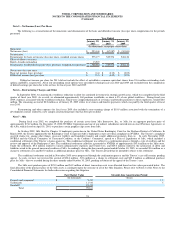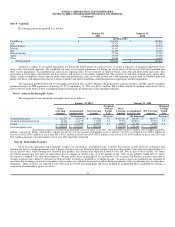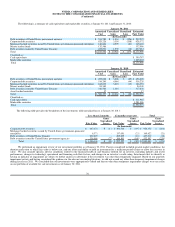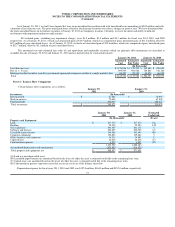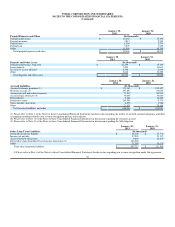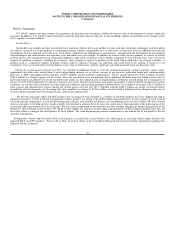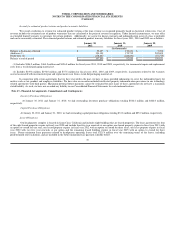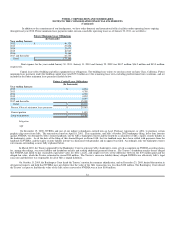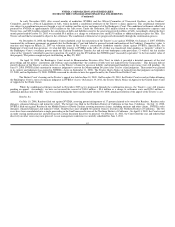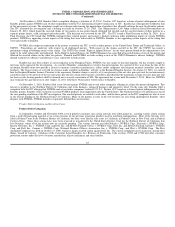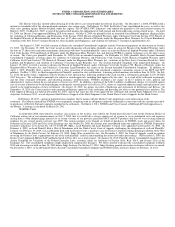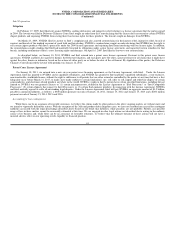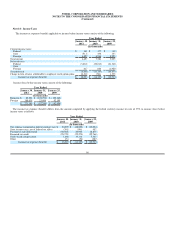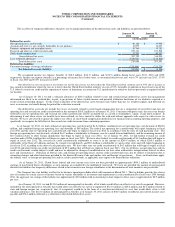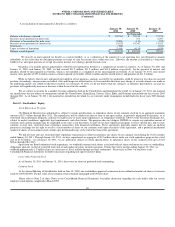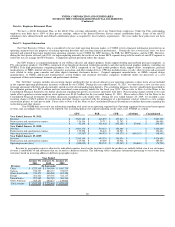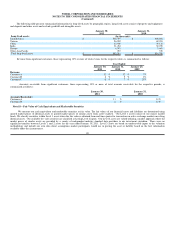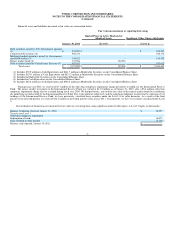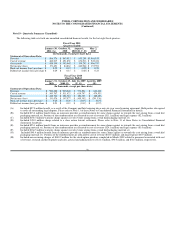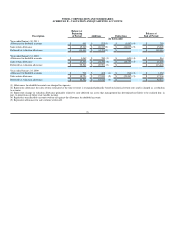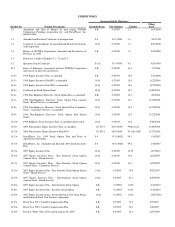NVIDIA 2011 Annual Report Download - page 87
Download and view the complete annual report
Please find page 87 of the 2011 NVIDIA annual report below. You can navigate through the pages in the report by either clicking on the pages listed below, or by using the keyword search tool below to find specific information within the annual report.
NVIDIA CORPORATION AND SUBSIDIARIES
NOTES TO THE CONSOLIDATED FINANCIAL STATEMENTS
(Continued)
The District Court has entered orders deeming all of the above cases related under the relevant local rules. On December 11, 2008, NVIDIA filed a
motion to consolidate all of the aforementioned consumer class action cases. On February 26, 2009, the District Court consolidated the cases, as well as two
other cases pending against Hewlett Packard, under the caption “The NVIDIA GPU Litigation” and ordered the plaintiffs to file lead counsel motions by
March 2, 2009. On March 2, 2009, several of the parties filed motions for appointment of lead counsel and briefs addressing certain related issues. On April
10, 2009, the District Court appointed Milberg LLP lead counsel. On May 6, 2009, the plaintiffs filed an Amended Consolidated Complaint, alleging claims
for violations of California Business and Professions Code Section 17200, Breach of Implied Warranty under California Civil Code Section 1792, Breach of
the Implied Warranty of Merchantability under the laws of 27 other states, Breach of Warranty under the Magnuson-Moss Warranty Act, Unjust Enrichment,
violations of the New Jersey Consumer Fraud Act, Strict Liability and Negligence, and violation of California’s Consumer Legal Remedies Act.
On August 19, 2009, we filed a motion to dismiss the Amended Consolidated Complaint, and the Court heard arguments on that motion on October
19, 2009. On November 19, 2009, the Court issued an order dismissing with prejudice plaintiffs causes of action for Breach of the Implied Warranty under
the laws of 27 other states and unjust enrichment, dismissing with leave to amend plaintiffs’ causes of action for Breach of Implied Warranty under California
Civil Code Section 1792 and Breach of Warranty under the Magnuson-Moss Warranty Act, and denying NVIDIA’s motion to dismiss as to the other causes
of action. The Court gave plaintiffs until December 14, 2009 to file an amended complaint. On December 14, 2009, plaintiffs filed a Second Amended
Consolidated Complaint, asserting claims for violations of California Business and Professions Code Section 17200, Breach of Implied Warranty under
California Civil Code Section 1792, Breach of Warranty under the Magnuson-Moss Warranty Act, violations of the New Jersey Consumer Fraud Act, Strict
Liability and Negligence, and violation of California’s Consumer Legal Remedies Act. The Second Amended Complaint seeks unspecified damages. On
January 19, 2010, we filed a motion to dismiss the Breach of Implied Warranty under California Civil Code Section 1792, Breach of Warranty under the
Magnuson-Moss Warranty Act, and California’s Consumer Legal Remedies Act claims in the Second Amended Consolidated Complaint. In addition, on
April 1, 2010, Plaintiffs filed a motion to certify a class consisting of all people who purchased computers containing certain of our MCP and GPU
products. On May 3, 2010, we filed an opposition to Plaintiffs’ motion for class certification. A hearing on both motions was held on June 14, 2010. On July
16, 2010, the parties filed a stipulation with the District Court advising that, following mediation they had reached a settlement in principle in The NVIDIA
GPU Litigation. The settlement in principle was subject to certain approvals, including final approval by the court. As a result of the settlement in principle,
and the other estimated settlement, and offsetting insurance reimbursements, NVIDIA recorded a net charge of $12.7 million to sales, general and
administrative expense during the second quarter of fiscal year 2011. In addition, a portion of the $181.2 million of additional charges we recorded against
cost of revenue related to the weak die/packaging set during the second quarter of fiscal year 2011, relates to estimated additional repair and replacement costs
related to the implementation of these settlements. On August 12, 2010, the parties executed a Stipulation and Agreement of Settlement and Release. On
September 15, 2010, the Court issued an order granting preliminary approval of the settlement and providing for notice to the potential class members. The
Final Approval Hearing was held on December 20, 2010, and on that same day the Court approved the settlement and entered Final Judgment over several
objections. In January 2011, several objectors filed Notices of Appeal of the Final Judgment to the United States Court of Appeals for the Ninth Circuit.
On February 28, 2011, a group of purported class members filed a motion with the District Court purporting to seek enforcement of the
settlement. The Motion claimed that NVIDIA was not properly complying with its obligations under the settlement in connection with the remedies provided
to purchasers of Hewlett-Packard computers included in the settlement. On March 4, 2011, NVIDIA and Class Counsel at Milberg LLP filed oppositions to
the Motion. A hearing is scheduled for March 28, 2011.
Securities Cases
In September 2008, three putative securities class actions, or the Actions, were filed in the United States District Court for the Northern District of
California arising out of our announcements on July 2, 2008, that we would take a charge against cost of revenue to cover anticipated costs and expenses
arising from a weak die/packaging material set in certain versions of our previous generation MCP and GPU products and that we were revising financial
guidance for our second quarter of fiscal year 2009. The Actions purport to be brought on behalf of purchasers of NVIDIA stock and assert claims for
violations of Sections 10(b) and 20(a) of the Exchange Act. On October 30, 2008, the Actions were consolidated under the caption In re NVIDIA Corporation
Securities Litigation, Civil Action No. 08-CV-04260-JW (HRL). Lead Plaintiffs and Lead Plaintiffs’ Counsel were appointed on December 23, 2008. On
February 6, 2009, co-Lead Plaintiff filed a Writ of Mandamus with the Ninth Circuit Court of Appeals challenging the designation of co-Lead Plaintiffs’
Counsel. On February 19, 2009, co-Lead Plaintiff filed with the District Court, a motion to stay the District Court proceedings pending resolution of the Writ
of Mandamus by the Ninth Circuit. On February 24, 2009, Judge Ware granted the stay. On November 5, 2009, the Court of Appeals issued an opinion
reversing the District Court’s appointment of one of the lead plaintiffs’ counsel, and remanding the matter for further proceedings. On December 8, 2009, the
District Court appointed Milberg LLP and Kahn Swick & Foti, LLC as co-lead counsel. On January 22, 2010, Plaintiffs filed a Consolidated Amended Class
Action Complaint for Violations of the Federal Securities Laws, asserting claims for violations of Section 10(b), Rule 10b-5, and Section 20(a) of the
Exchange Act. The consolidated complaint sought unspecified compensatory damages. We filed a motion to dismiss the consolidated complaint in March
2010 and a hearing was held on June 24, 2010 before Judge Seeborg. On October 19, 2010, Judge Seeborg granted our motion to dismiss with leave to amend.
On December 2, 2010, co-Lead Plaintiffs filed a Second Consolidated Amended Complaint and NVIDIA filed a motion to dimiss on February 14, 2011.
84


